Your Symptoms of rinderpest disease in animals images are ready. Symptoms of rinderpest disease in animals are a topic that is being searched for and liked by netizens today. You can Find and Download the Symptoms of rinderpest disease in animals files here. Get all free vectors.
If you’re looking for symptoms of rinderpest disease in animals pictures information connected with to the symptoms of rinderpest disease in animals keyword, you have pay a visit to the ideal site. Our website frequently gives you suggestions for downloading the highest quality video and image content, please kindly search and find more informative video articles and images that match your interests.
Symptoms Of Rinderpest Disease In Animals. After an incubation period of three to nine days fever and loss of. Only mild symptoms of the disease when infected but for cattle and buffalo mortality rates can reach up to 100 per cent in highly susceptible herds. The OIE Terrestrial Animal Health Code contains detailed recommendations on the prevention and control of rinderpest in the event that there is a recurrence of the disease. In the post-eradication era testing for rinderpest preferably using molecular methods should be considered when an etiologic agent cannot be determined for an infectious disease with characteristic signs of rinderpest.
 Manual On The Preparation Of Rinderpest Contingency Plans From fao.org
Manual On The Preparation Of Rinderpest Contingency Plans From fao.org
In cattle the most susceptible species classical signs of the disease include fever erosive lesions in the mouth discharge from the nose and eyes profuse diarrhoea and dehydration often leading to death within 10 to 15 days. The paper discusses the differential diagnosis of the rinderpest with respect to mucosal disease malignent catarrhal fever Nairobi sheep disease salmonellosis pasteurellosis and coccidiosis. Many species of wild and domestic cloven-hoofed animals including sheep and goats show milder symptoms of the disease when infected but the mortality rate can reach up to 100 per cent in highly susceptible cattle or buffalo herdsThe OIE Terrestrial Animal Health Code contains detailed recommendations on prevention and control of rinderpest. Rinderpest is usually milder in sheep and goats than cattle and some infections are subclinical. Many species of wild and domestic cloven-hoofed animals including sheep and goats show milder symptoms of the disease when infected. The clinical signs may include fever and anorexia with diarrhea in some animals.
In cattle difficulties could arise in distinguishing rinderpest from mucosal disease MD malignant catarrhal fever infectious bovine rhinotracheitis particularly when caused by strains that induce diarrhoea papular stomatitis Jembrana disease and foot-and-mouth disease.
Rinderpest is caused by a virus of the family Paramyxoviridae genus Morbillivirus. Only mild symptoms of the disease when infected but for cattle and buffalo mortality rates can reach up to 100 per cent in highly susceptible herds. Rinderpest is usually milder in sheep and goats than cattle and some infections are subclinical. Swine are doubtfully affected. Many species of wild and domestic cloven-hoofed animals including sheep and goats show milder symptoms of the disease when infected but the mortality rate can reach up to 100 per cent in highly susceptible cattle or buffalo herdsThe OIE Terrestrial Animal Health Code contains detailed recommendations on prevention and control of rinderpest. In other species rinderpest may show milder clinical signs.
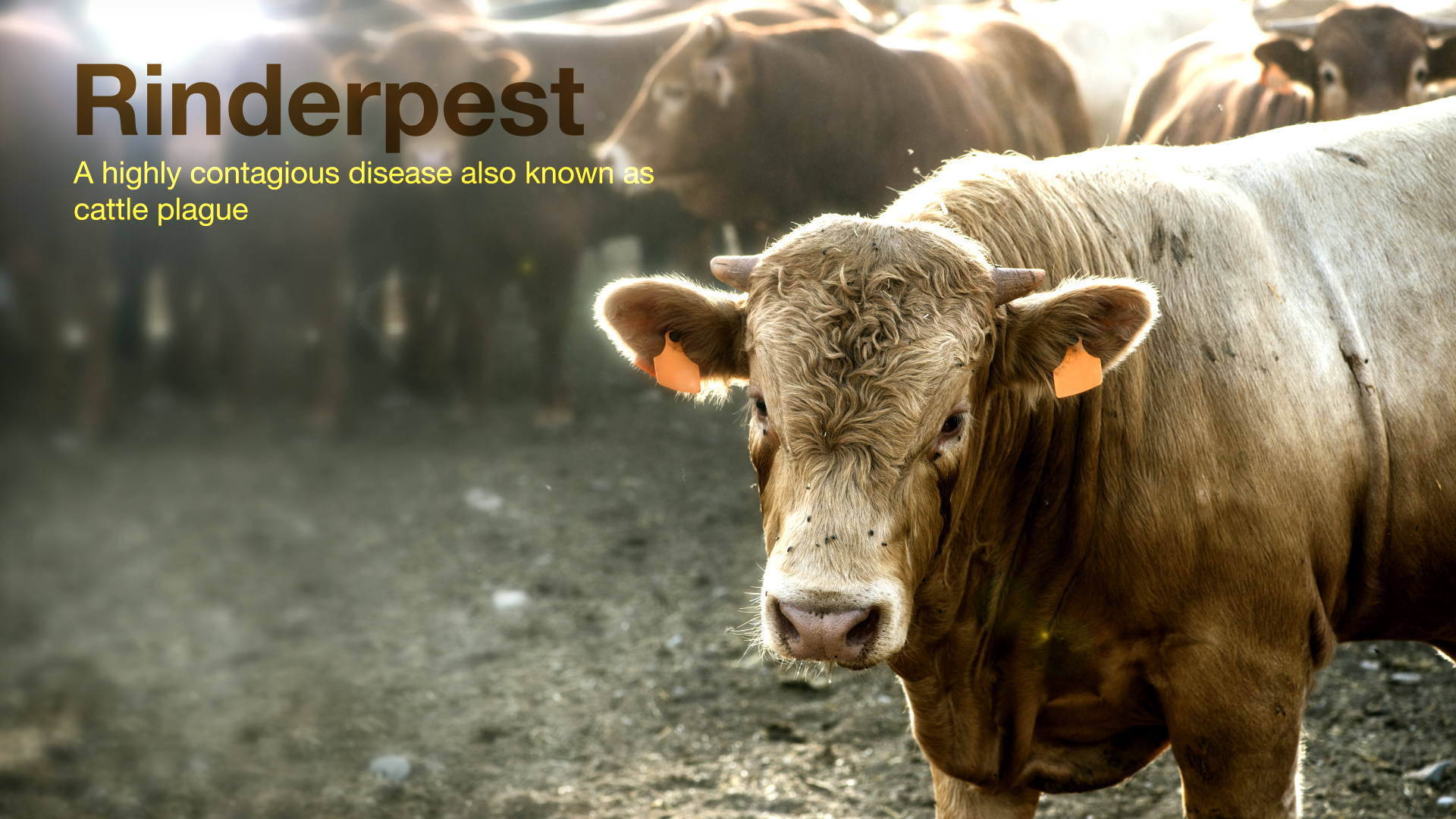 Source: scientificanimations.com
Source: scientificanimations.com
In cattle difficulties could arise in distinguishing rinderpest from mucosal disease MD malignant catarrhal fever infectious bovine rhinotracheitis particularly when caused by strains that induce diarrhoea papular stomatitis Jembrana disease and foot-and-mouth disease. Rinderpest was a viral disease of cattle and other ruminants domestic and wild characterized by fever erosive stomatitis diarrhea and high morbidity and mortality. The respiration and pulse are accelerated and in the initial stage cough is common in many animals without any physical sounds in the lungs. In cattle difficulties could arise in distinguishing rinderpest from mucosal disease MD malignant catarrhal fever infectious bovine rhinotracheitis particularly when caused by strains that induce diarrhoea papular stomatitis Jembrana disease and foot-and-mouth disease. In cattle the most susceptible species classical signs of the disease include fever erosive lesions in the mouth discharge from the nose and eyes profuse diarrhoea and dehydration often leading to death within 10 to 15 days.

In the post-eradication era testing for rinderpest should be considered when an etiologic agent cannot be determined for an infectious disease with characteristic signs of rinderpest. Rinderpest causes loss of appetite and weight. Rinderpest is caused by a virus of the family Paramyxoviridae genus Morbillivirus. In the post-eradication era testing for rinderpest should be considered when an etiologic agent cannot be determined for an infectious disease with characteristic signs of rinderpest. Many species of wild and domestic cloven-hoofed animals including sheep and goats show milder symptoms of the disease when infected but the mortality rate can reach up to 100 per cent in highly susceptible cattle or buffalo herdsThe OIE Terrestrial Animal Health Code contains detailed recommendations on prevention and control of rinderpest.

Rinderpest was a viral disease of cattle and other ruminants domestic and wild characterized by fever erosive stomatitis diarrhea and high morbidity and mortality. Introduction Rinderpest Rinderpest also cattle plague or steppe murrain was an infectious viral disease of cattle domestic buffalo and some other species of even-toed ungulates including buffaloes large antelope and deer giraffes wildebeests and warthogsIt is characterized by the fever oral lesion persistent diarrhea lymphoid leuckosis and high mortality rateIt is also called pest. The clinical signs may include fever and anorexia with diarrhea in some animals. After an incubation period of three to nine days fever and loss of. In cattle difficulties could arise in distinguishing rinderpest from mucosal disease MD malignant catarrhal fever infectious bovine rhinotracheitis particularly when caused by strains that induce diarrhoea papular stomatitis Jembrana disease and foot-and-mouth disease.
 Source: dhahabu.co.ke
Source: dhahabu.co.ke
Severe cases with necrotic stomatitis oculonasal. Introduction Rinderpest Rinderpest also cattle plague or steppe murrain was an infectious viral disease of cattle domestic buffalo and some other species of even-toed ungulates including buffaloes large antelope and deer giraffes wildebeests and warthogsIt is characterized by the fever oral lesion persistent diarrhea lymphoid leuckosis and high mortality rateIt is also called pest. Rinderpest was caused by a paramyxovirus genus Morbillivirus closely related to those that cause measles in humans and viral distemper in dogs. The urine is scanty and dark coloured. Rinderpest was a viral disease of cattle and other ruminants domestic and wild characterized by fever erosive stomatitis diarrhea and high morbidity and mortality.
 Source: lrd.spc.int
Source: lrd.spc.int
Rinderpest also known as cattle plague is a contagious viral disease affecting cloven-hoofed animals mainly cattle and buffalo. In the post-eradication era testing for rinderpest preferably using molecular methods should be considered when an etiologic agent cannot be determined for an infectious disease with characteristic signs of rinderpest. Rinderpest was a viral disease of cattle and other ruminants domestic and wild characterized by fever erosive stomatitis diarrhea and high morbidity and mortality. Rinderpest was caused by a paramyxovirus genus Morbillivirus closely related to those that cause measles in humans and viral distemper in dogs. Many species of wild and domestic cloven-hoofed animals including sheep and goats show milder symptoms of the disease when infected but the mortality rate can reach up to 100 per cent in highly susceptible cattle or buffalo herdsThe OIE Terrestrial Animal Health Code contains detailed recommendations on prevention and control of rinderpest.

Swine are doubtfully affected. The respiration and pulse are accelerated and in the initial stage cough is common in many animals without any physical sounds in the lungs. Many species of wild and domestic cloven-hoofed animals including sheep and goats show milder symptoms of the disease when infected but the mortality rate can reach up to 100 per cent in highly susceptible cattle or buffalo herdsThe OIE Terrestrial Animal Health Code contains detailed recommendations on prevention and control of rinderpest. Starting from the clinical symptoms and the pathological-anatomical changes hints are given on the diagnosis of the rinderpest and how to distinguish it from other diseases. Rinderpest is caused by a virus of the family Paramyxoviridae genus Morbillivirus.

In the post-eradication era testing for rinderpest should be considered when an etiologic agent cannot be determined for an infectious disease with characteristic signs of rinderpest. Rinderpest is caused by a virus of the family Paramyxoviridae genus Morbillivirus. Rinderpest causes loss of appetite and weight. Many species of wild and domestic cloven-hoofed animals including sheep and goats show milder symptoms of the disease when infected but the mortality rate can reach up to 100 per cent in highly susceptible cattle or buffalo herdsThe OIE Terrestrial Animal Health Code contains detailed recommendations on prevention and control of rinderpest. In cattle the most susceptible species classical signs of the disease include fever erosive lesions in the mouth discharge from the nose and eyes profuse diarrhoea and dehydration often leading to death within 10 to 15 days.
 Source: fao.org
Source: fao.org
Rinderpest is one of seven diseases for which the OIE had established official recognition. The clinical signs may include fever and anorexia with diarrhea in some animals. Severe cases with necrotic stomatitis oculonasal. The OIE Terrestrial Animal Health Code contains detailed recommendations on the prevention and control of rinderpest in the event that there is a recurrence of the disease. In other species rinderpest may show milder clinical signs.
 Source: lrd.spc.int
Source: lrd.spc.int
Disease cattle countries injection animals europe symptoms fever blood and days RINDERPEST German for cattle-plague which is the English synonym one of the most contagious infectious and fatal diseases of oxen. The OIE Terrestrial Animal Health Code contains detailed recommendations on the prevention and control of rinderpest in the event that there is a recurrence of the disease. The virus was transmitted by close direct or indirect contact. In cattle the most susceptible species classical signs of the disease include fever erosive lesions in the mouth discharge from the nose and eyes profuse diarrhoea and dehydration often leading to death within 10 to 15 days. Rinderpest also known as cattle plague is a contagious viral disease affecting cloven-hoofed animals mainly cattle and buffalo.
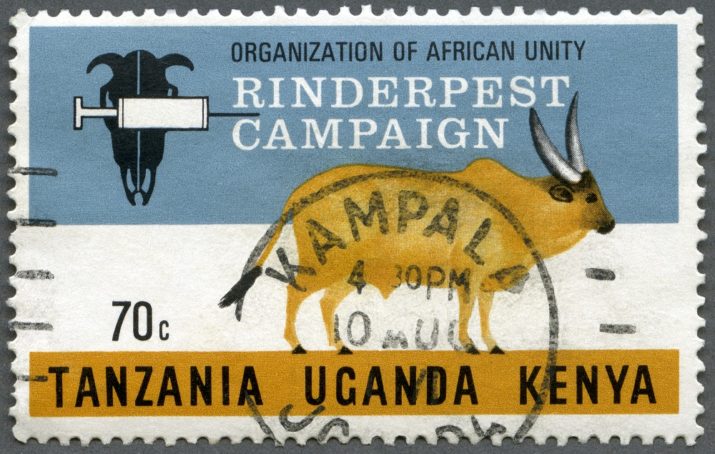 Source: europenowjournal.org
Source: europenowjournal.org
Disease cattle countries injection animals europe symptoms fever blood and days RINDERPEST German for cattle-plague which is the English synonym one of the most contagious infectious and fatal diseases of oxen. After an incubation period of three to nine days fever and loss of. It causes blood stained diarrhoea. Disease if they spread to susceptible wildlife such as Asian buffalo giraffe eland and lesser kudu. Rinderpest is usually milder in sheep and goats than cattle and some infections are subclinical.
 Source: lrd.spc.int
Source: lrd.spc.int
It causes blood stained diarrhoea. Only mild symptoms of the disease when infected but for cattle and buffalo mortality rates can reach up to 100 per cent in highly susceptible herds. Rinderpest was caused by a paramyxovirus genus Morbillivirus closely related to those that cause measles in humans and viral distemper in dogs. The respiration and pulse are accelerated and in the initial stage cough is common in many animals without any physical sounds in the lungs. Swine are doubtfully affected.
 Source: sciencedirect.com
Source: sciencedirect.com
Transmissible to sheep goats and other ruminants both domesticated and wild. Disease if they spread to susceptible wildlife such as Asian buffalo giraffe eland and lesser kudu. The respiration and pulse are accelerated and in the initial stage cough is common in many animals without any physical sounds in the lungs. The OIE Terrestrial Animal Health Code contains detailed recommendations on the prevention and control of rinderpest in the event that there is a recurrence of the disease. The urine is scanty and dark coloured.
 Source: publicdomainfiles.com
Source: publicdomainfiles.com
Transmissible to sheep goats and other ruminants both domesticated and wild. The paper discusses the differential diagnosis of the rinderpest with respect to mucosal disease malignent catarrhal fever Nairobi sheep disease salmonellosis pasteurellosis and coccidiosis. After an incubation period of three to nine days fever and loss of. Swine are doubtfully affected. From the second or third day of the manifestation of the disease inflammatory or necrotic changes in the mucosa develop.
 Source: fao.org
Source: fao.org
The clinical signs may include fever and anorexia with diarrhea in some animals. Rinderpest was caused by a paramyxovirus genus Morbillivirus closely related to those that cause measles in humans and viral distemper in dogs. The OIE Terrestrial Animal Health Code contains detailed recommendations on the prevention and control of rinderpest in the event that there is a recurrence of the disease. Rinderpest is caused by a virus of the family Paramyxoviridae genus Morbillivirus. Only mild symptoms of the disease when infected but for cattle and buffalo mortality rates can reach up to 100 per cent in highly susceptible herds.
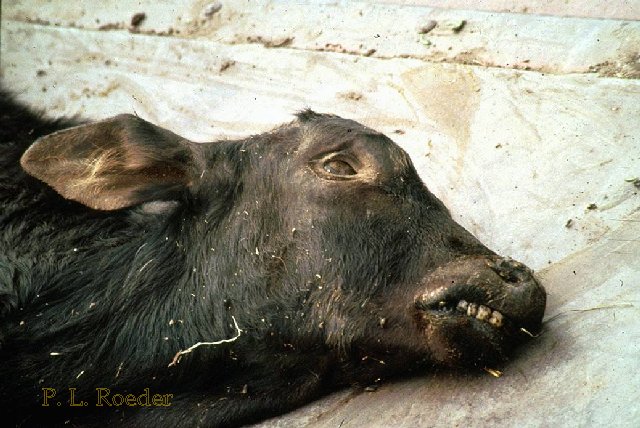 Source: vetmed.tamu.edu
Source: vetmed.tamu.edu
From the second or third day of the manifestation of the disease inflammatory or necrotic changes in the mucosa develop. Rinderpest also known as cattle plague is a contagious viral disease affecting cloven-hoofed animals mainly cattle and buffalo. In cattle difficulties could arise in distinguishing rinderpest from mucosal disease MD malignant catarrhal fever infectious bovine rhinotracheitis particularly when caused by strains that induce diarrhoea papular stomatitis Jembrana disease and foot-and-mouth disease. Disease if they spread to susceptible wildlife such as Asian buffalo giraffe eland and lesser kudu. Many species of wild and domestic cloven-hoofed animals including sheep and goats show milder symptoms of the disease when infected but the mortality rate can reach up to 100 per cent in highly susceptible cattle or buffalo herdsThe OIE Terrestrial Animal Health Code contains detailed recommendations on prevention and control of rinderpest.
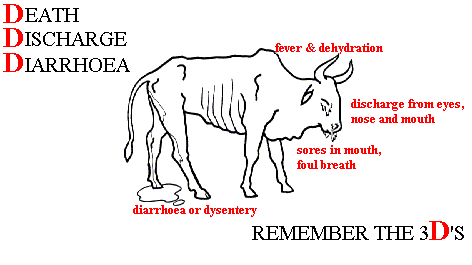 Source: pickingupthetabb.wordpress.com
Source: pickingupthetabb.wordpress.com
The virus was transmitted by close direct or indirect contact. The virus was transmitted by close direct or indirect contact. Severe cases with necrotic stomatitis oculonasal. Rinderpest was a viral disease of cattle and other ruminants domestic and wild characterized by fever erosive stomatitis diarrhea and high morbidity and mortality. Starting from the clinical symptoms and the pathological-anatomical changes hints are given on the diagnosis of the rinderpest and how to distinguish it from other diseases.
 Source: lrd.spc.int
Source: lrd.spc.int
The paper discusses the differential diagnosis of the rinderpest with respect to mucosal disease malignent catarrhal fever Nairobi sheep disease salmonellosis pasteurellosis and coccidiosis. In other species rinderpest may show milder clinical signs. In the post-eradication era testing for rinderpest should be considered when an etiologic agent cannot be determined for an infectious disease with characteristic signs of rinderpest. Many species of wild and domestic cloven-hoofed animals including sheep and goats show milder symptoms of the disease when infected. Many species of wild and domestic cloven-hoofed animals including sheep and goats show milder symptoms of the disease when infected but the mortality rate can reach up to 100 per cent in highly susceptible cattle or buffalo herdsThe OIE Terrestrial Animal Health Code contains detailed recommendations on prevention and control of rinderpest.
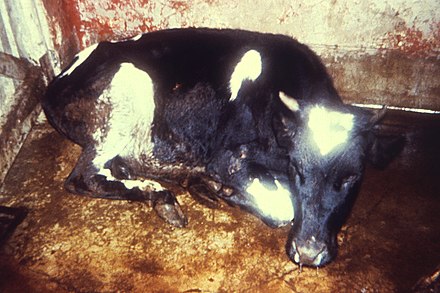 Source: wikiwand.com
Source: wikiwand.com
Severe cases with necrotic stomatitis oculonasal. In cattle difficulties could arise in distinguishing rinderpest from mucosal disease MD malignant catarrhal fever infectious bovine rhinotracheitis particularly when caused by strains that induce diarrhoea papular stomatitis Jembrana disease and foot-and-mouth disease. Starting from the clinical symptoms and the pathological-anatomical changes hints are given on the diagnosis of the rinderpest and how to distinguish it from other diseases. Many species of wild and domestic cloven-hoofed animals including sheep and goats show milder symptoms of the disease when infected. Rinderpest is one of seven diseases for which the OIE had established official recognition.
This site is an open community for users to share their favorite wallpapers on the internet, all images or pictures in this website are for personal wallpaper use only, it is stricly prohibited to use this wallpaper for commercial purposes, if you are the author and find this image is shared without your permission, please kindly raise a DMCA report to Us.
If you find this site beneficial, please support us by sharing this posts to your preference social media accounts like Facebook, Instagram and so on or you can also bookmark this blog page with the title symptoms of rinderpest disease in animals by using Ctrl + D for devices a laptop with a Windows operating system or Command + D for laptops with an Apple operating system. If you use a smartphone, you can also use the drawer menu of the browser you are using. Whether it’s a Windows, Mac, iOS or Android operating system, you will still be able to bookmark this website.





